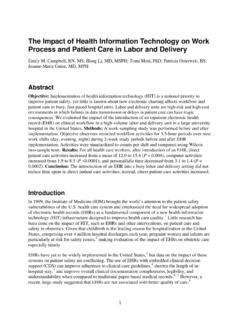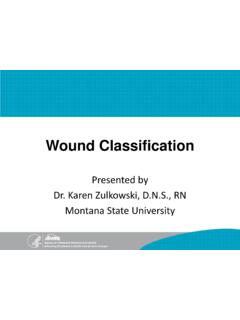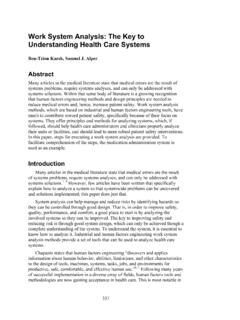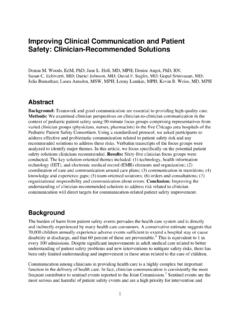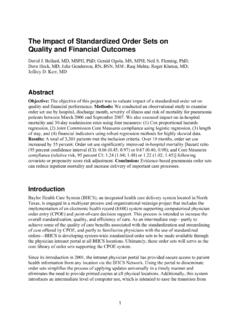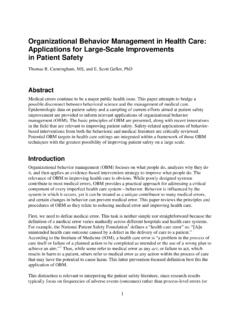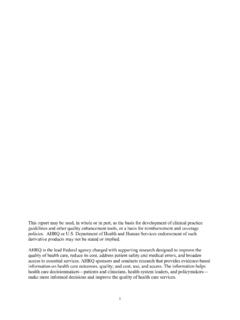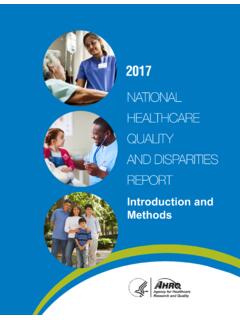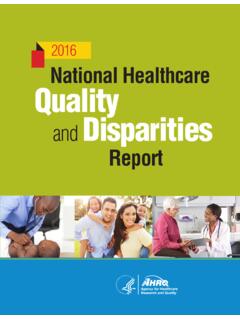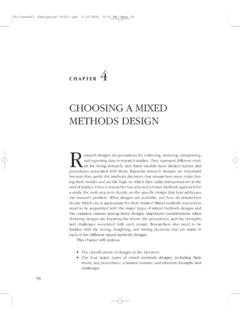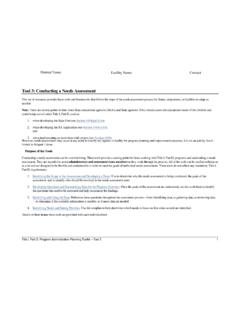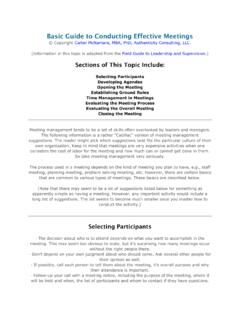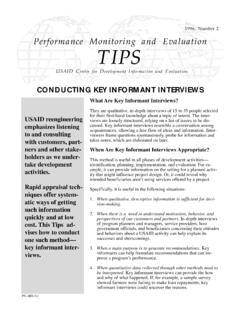Transcription of Conducting a Comprehensive Skin Assessment
1 Conducting a Comprehensive skin AssessmentPresented by Dr. Karen Zulkowski, , RNMontana State UniversityWelcome!Thank you for joining this webinar about how to conduct a Comprehensive skin Little About An associate professor at Montana State University Executive editor of the Journal of the World Council of EnterostomalTherapists(JWCET) and WCET International Ostomy Guidelines (2014) Member of the editorial board of Ostomy Wound Management and Advances in skin and Wound Care Legal consultant and former NPUAP board member3 Today We Will Talk About Attributes and goals of Comprehensive skin Assessment How to conduct Comprehensive skin Assessment Treating Comprehensive skin Assessment as a separate process Integrating Comprehensive skin Assessment into the normal workflow Documenting and reporting results Improving Comprehensive skin Assessment Comprehensive skin Assessment and care planning4 Today We Will Talk AboutThese skin Assessment topics were introduced in your 1-day training.
2 Today, we will revisit them in depth. Please make a note of your questions. Your Quality Improvement (QI) Specialists will follow up with you after this webinar to address and Goals of Comprehensive skin Assessment Attributes of Comprehensive skin Assessment Goals of Comprehensive skin assessment6 Attributes of Comprehensive skin Assessment Process of examining entire skin for abnormalities Requires looking at and touching skin from head to toe7 Goals of Comprehensive skin Assessment Identify any pressure ulcers. Find out if there are other lesions or skin -related factors that predispose the patient to develop pressure ulcers. Factors include excessively dry skin and moisture-associated skin damage (MASD).8 Goals of Comprehensive skin Assessment Identify other important skin conditions.
3 Provide data needed to calculate pressure ulcer incidence and prevalence. Stratify risk. Patients with existing pressure ulcers are at risk for more. Identify care planning To Conduct Comprehensive skin Assessment Standard protocol for Comprehensive skin Assessment 5 parameters of Comprehensive skin Assessment skin Assessment of bariatric patients10 Standard Protocol for ComprehensiveSkin Assessment Explain to the patient and family that you will be checking the patient s entire skin . Explain what you are looking for with each site. Conduct the Assessment in a private space. Make sure the patient is comfortable. Wash and sanitize your hands before and after the Protocol for ComprehensiveSkin Assessment Wear gloves, and change them as needed. Minimize exposure of body parts.
4 Provide privacy with a sheet or cover. Ask for help to turn the patient as your facility s policies and Protocol for Comprehensive skin AssessmentPay special attention to skin beneath and around any devices or compression stockings Bony prominences (heels, sacrum, occiput) skin to skin areas, such as the penis, back of knees, inner thighs, and buttocks All areas where the patient Lacks sensation to feel pain Had a breakdown previously Also pay special attention if the patient is getting epidural/spinal pain Parameters of Comprehensive skin (firmness) integrity skin intact Open areas, rashes, 1: skin Temperature Palpate with your hand to assess skin temperature. skin warmth or coolness can indicate skin damage, including Stage I pressure ulcer Suspected deep tissue injury Preulceration in the diabetic foot Inflammation or infection15 Parameter 2: skin Turgor (Firmness) skin normally returns to its original state quickly when stretched.
5 Can you tent the skin ? skin may be slow to return to its original shape in older or dehydrated 3: skin Color Compare adjacent areas of skin for color. Redness can indicate many skin problems Pressure ulcer Rash Infection, cellulitis Deficiencies can also affect skin : Vitamin C deficiency causes purplish blotches on lightly traumatized areas. Zinc deficiency causes redness of the nasolabial fold and eyebrows. 17 Parameter 3: skin Color Blanchable versus nonblanchable erythema Purple or bruised looking skin Paper-thin skin Dark or reddened areas18 Darkly pigmented skin does not 3: skin ColorRedness Reddened skin on the sacral area can be from a variety of etiologies. Make sure to get the etiology right so you can treat the cause skin damageStage I pressure ulcer19 Parameter 4: skin MoistureMoisture-associated skin damage: skin can be dry (verosis) or damaged from too much wetness (maceration).
6 Etiology can be Incontinence, urine, stool, or both Wound exudate Perspiration, including patients with a fever Between skin folds (especially in bariatric patients) Ostomy or fistula that leaks Make sure to get the etiology right so you can treat the cause 5: skin Integrity skin should be intact. If skin is notintact, identify the etiology of the skin problem. Etiology could be Pressure Peripheral vascular (venous or arterial) Neuropathic/diabetic skin tears (especially forearm of older adults) Trauma Make sure to get the etiology right so you can treat the cause Assessment of Bariatric Patients Inner aspect of thighs and skin folds Rash Maceration Infection (bacteria or candidiasis) Breakdown22 skin Assessment of Bariatric Patients Perineum Dermatitis Candidiasis Extremities Vascular changes Edema Lymphedema23 Treating Comprehensive skin Assessment As Separate ProcessComprehensive skin Assessment Requires a specific focus by staff.
7 Must be standardized and Comprehensive skin Assessment As Separate ProcessFrequencyof Comprehensive skin Assessment Depends on the needs of the unit May be as often as every shift Is most often daily and when the patient is Newly admitted Moved to a different level of care Transferred Discharged25 Integrating skin Assessment Into Normal WorkflowEach time you Apply oxygen, check the patient s ears for pressure areas from tubing Check bowel sounds, look at skin folds Reposition the patient in bed, check the back of the patient s head26 Integrating skin Assessment Into Normal WorkflowEach time you Auscultate lung sounds or turn the patient, check the patient s shoulders, back, and sacral/coccyx region Check a male patient s catheter, check his penis Position pillows under the patient s calves, check the heels and feet Use a hand-held mirror to adequately visualize the skin Assessment Into Normal WorkflowEach time you Check IV sites, look at the patient s arms and elbows Lift the patient or provide care, check exposed skin , especially on bony prominences Remove equipment, check adjacent skin This includes TENS units, restraints, splints, oxygen tubing, and endotracheal and Reporting Results Documenting results Reporting results29 Documenting Results Document the results of Comprehensive skin Assessment in each patient s medical record even if there are no problems.
8 Have a standardized place to record results in the medical record. Options include Checklist or standardized computer screens with key descriptors of the 5 Parameters Diagram of a body outline where staff can note any skin changes they observe30 Make sure all staff know how and where to document Ulcer Identification Pocket Pad31 Tool 3C Page 132 Documenting ResultsThink about keeping a unit wide log. For each patient, record Whether he/she has pressure ulcers How many pressure ulcers he/she has Highest stage of his/her deepest ulcer Treatment for any existing wounds 32 Reporting Results Include results in all shift reports. Make sure results are easy to access. If there are problems, report results to team members and to the patient s health care Results If you keep a unit wide log*, review the log on a regular basis to: Make sure Comprehensive skin Assessment has been done for each patient.
9 Make sure the Assessment and treatment orders are current. Assess your incidence and prevalence rates. 34 All staff should know what your unit incidence and prevalence rates are and why they matter.*Tool 5A Page 147 Improving Comprehensive skin AssessmentTrain all staff on: Whowill conduct Comprehensive skin Assessment : Nurse aide examines the skin each time he/she cleans or repositions the patient. Nurse makes sure the Assessment is Comprehensive and documented. Whyto conduct it. Whento conduct it. Howto conduct it. Whatto look Comprehensive skin AssessmentEncouragestaff to: Ask a colleague or expert to confirm their skin assessments. This hones skills and prevents errors. Ask questions as needed. Report any possible skin abnormalities they come across during routine Assessment and Braden ScaleYou need to look at both the skin Assessment and the risk Assessment from the Braden Scale to plan your care appropriately.
10 37 skin Assessment and Care Planning38 Assessing skinHead-to-toe skin assessmentPatient is admitted or readmittedDO BOTHC omplete head-to-toe skin and PU RISK Assessment on admissionDo both more frequently if significant change occurs or per facility protocolINSPECT AND PALPATED ocument all skin issues, including: skin colorSkin temperatureSkin turgorSkin moisture statusSkin integrity-Moisture-Moles-Bruises-Rashes- Incisions-Scars-BurnsAny abnormalitiesRemember to pay special attention to the feet and heelsDOCUMENTR eport anyabnormal findingsto HCP and notify & educate patient and family on findingsZulkowski& Ayello, 2010 skin Assessment and Care Planning39 Tool 3A Page 128 Today We Talked About Attributes and goals of Comprehensive skin Assessment How to conduct Comprehensive skin Assessment Treating Comprehensive skin Assessment as a separate process Integrating skin Assessment into the normal workflow Documenting and reporting results Improving Comprehensive skin Assessment skin Assessment and care planning40 Any Questions?

